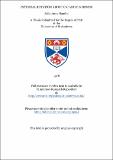Files in this item
Internal rotation about c-c and c-n bonds
Item metadata
| dc.contributor.advisor | Mackie, Raymond K. (Raymond Keith) | |
| dc.contributor.author | Hamlin, Sally-Anne | |
| dc.coverage.spatial | vi, 132 p. | en_US |
| dc.date.accessioned | 2018-07-09T09:34:36Z | |
| dc.date.available | 2018-07-09T09:34:36Z | |
| dc.date.issued | 1978 | |
| dc.identifier.uri | https://hdl.handle.net/10023/15094 | |
| dc.description.abstract | A study of the historical and more recent work on rotation about carbon-carbon and carbon-nitrogen bonds was the basis for the further investigation of three series of compounds: 1. 2,2'-disubstituted biphenyls, 2. N-benzyl-N-tosyl substituted anilines, 3. substituted quinone-anils. From this work it was established that, in certain compounds, the free energy (ΔG*) for hindered rotation cannot be discussed solely in steric terms but that electronic influences should also be considered. In. the substituted aniline series, it was concluded that a Hammett type correlation existed between the electronegativity of the substituents para to the amino group and the value of ΔG*. This correlation was extrapolated to explain the electronic influence of the substituents ortho to the amino group. Consideration was paid to the possibility that, for the ortho substituents, steric factors may outweigh electronic factors. An attempt was made to extend this correlation to explain the electronic influence of 2'- and 4'-substituents upon the ΔG* values and rates of racemization of-substituted biphenyls. However, it was found that the simple Hammett correlation was not followed and that, for the racemization studies, the entropy of activation (ΔS*) became a significant factor. The values of ΔG* for hindered rotation were obtained from the analysis of 100MHz n.m.r. spectra. The validity of these ΔG* values was discussed with respect to their accuracy and with respect to the effect of entropy. The synthetic routes used to obtain the three series of compounds were also discussed. The discussion of the synthetic routes includes the attempted preparations of a number of quinone-anils via the condensation of 2,6-di-t-butyl-l,4-benzoquinone with 4-substituted 2-benaylanilines. This was complicated by the production of impure samples of 2-benzylaniline and 2-benayl-4-chloroaniline. The synthesis of 2-benzyl-4-nitroaniline was not reproducible. The condensation reaction resulted in a number of products. These were separated by crystallization techniques and identified by high pressure liquid chromatography, I.R. spectroscopy, -13C and proton n.m.r. The structure of a new compound based on a dihydroindole containing one spiro carbon joined to a substituted quinone ring is proposed. | en_US |
| dc.language.iso | en | en_US |
| dc.publisher | University of St Andrews | |
| dc.subject.lcc | QD335.H2 | |
| dc.subject.lcsh | Aromatic compounds | en |
| dc.title | Internal rotation about c-c and c-n bonds | en_US |
| dc.type | Thesis | en_US |
| dc.type.qualificationlevel | Doctoral | en_US |
| dc.type.qualificationname | PhD Doctor of Philosophy | en_US |
| dc.publisher.institution | The University of St Andrews | en_US |
This item appears in the following Collection(s)
Items in the St Andrews Research Repository are protected by copyright, with all rights reserved, unless otherwise indicated.

